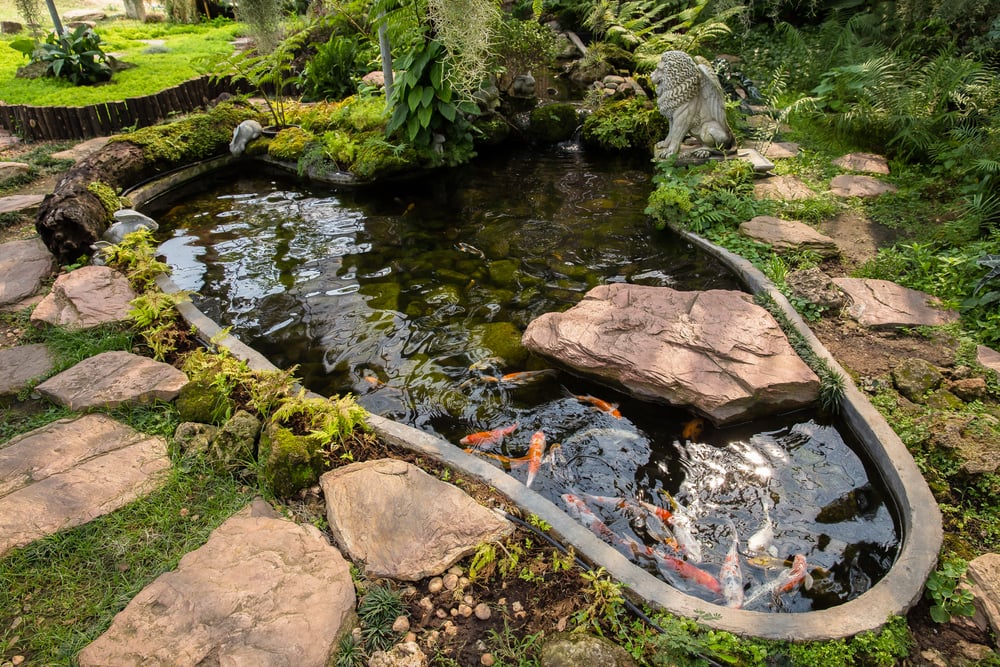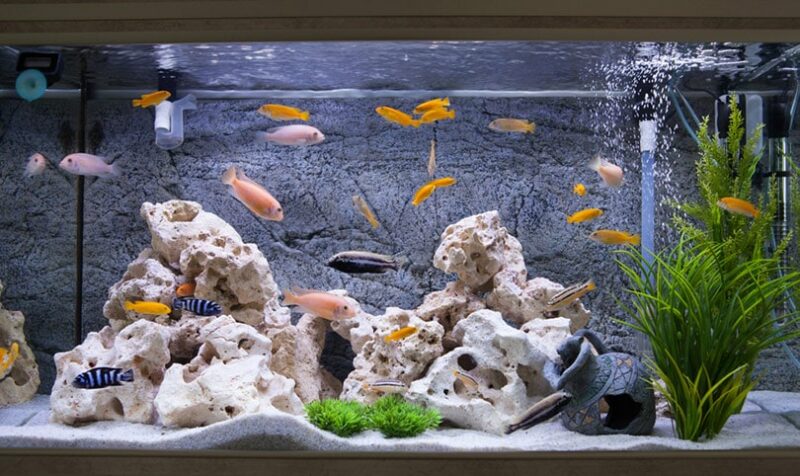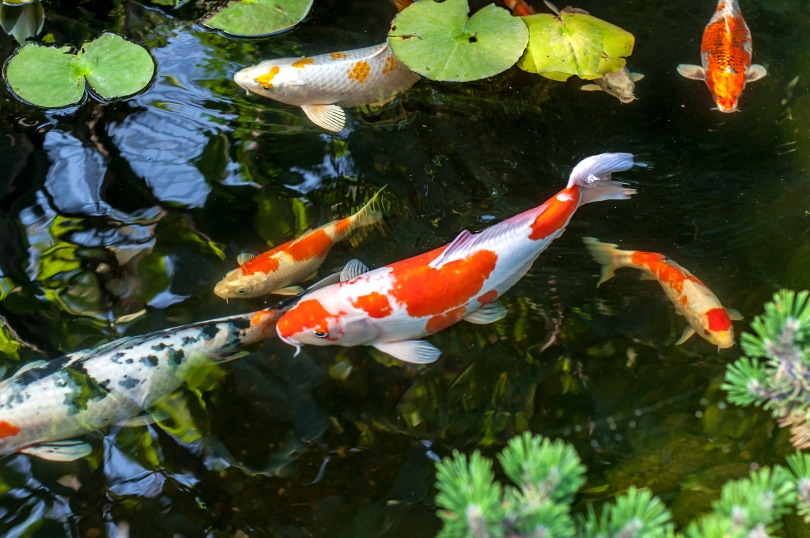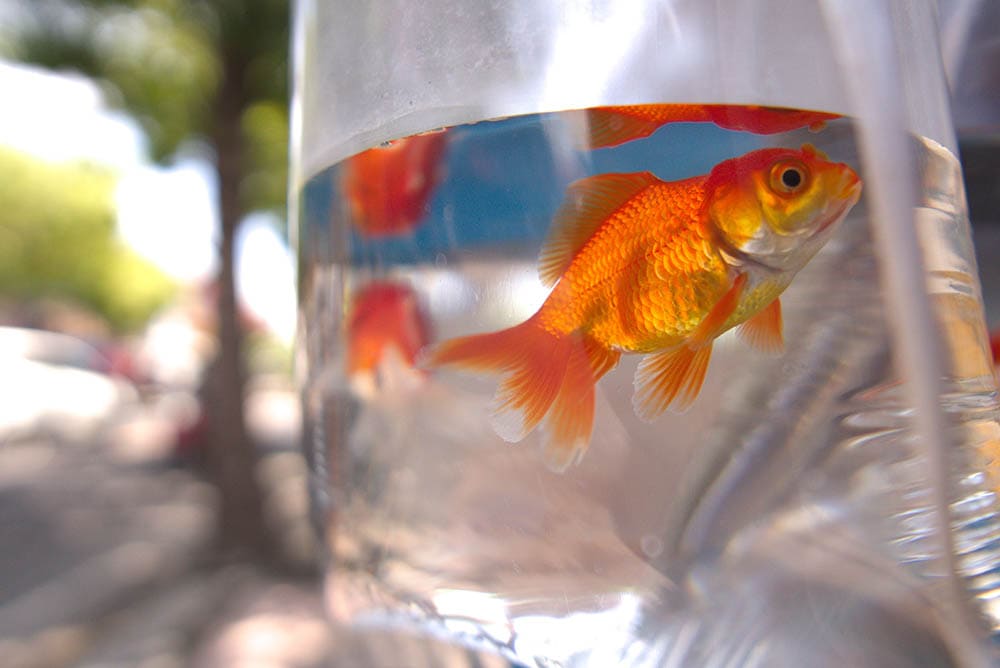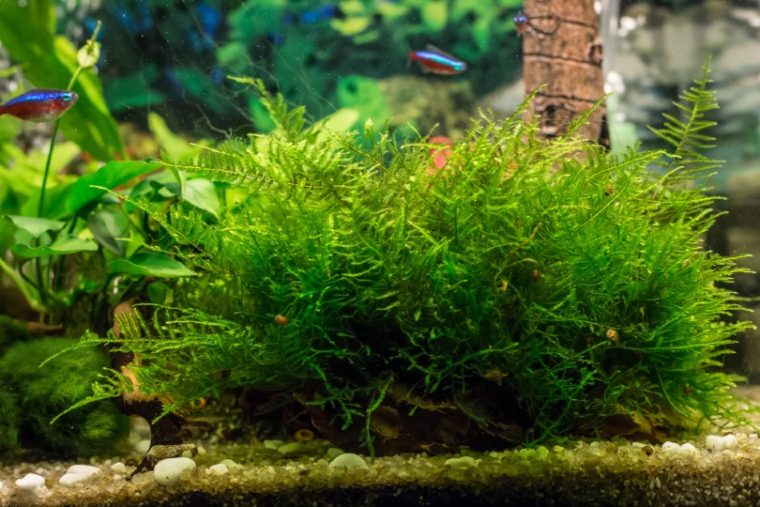
Java moss is an aquatic plant that “carpets” tanks the world over. Due to its low maintenance, it has become one of the most popular plants for hobbyists and fishkeepers.
Java moss is a member of the Hypnaceae family.1 It originates from Southeast Asia and gets its name from the Indonesian island of Java. This hardy plant grows in humid regions close to river banks and is found covering trees, rocks, and roots in the wild.
Java moss is perfect for aquariums because of its “cushion-like” texture which provides a safe spot for young fish (fry) and egg-laying. As well as oxygenating your tank and supporting a healthy environment, it also helps with waste control and provides food and shelter.
Useful Information About Java Moss

| Family Name: | Taxiphyllum Barbieri |
| Common Name: | Java moss |
| Origin: | Southeast Asia |
| Color: | Green |
| Size: | 2–4 inches high |
| Growth Rate: | Depends on water temperature |
| Care Level: | Low |
| Lighting: | Low or high |
| Water Conditions: | Most water types—ideal conditions between 21–24oC, soft acid water, moderate currents, PH 5–8 |
| Minimum Tank Size: | 5 gallons |
| Supplements: | Not required |
| Placement: | Bottom of the tank, tank walls, the base of other plants, over rocks or driftwood |
| Propagation: | Division |
| Compatibility: | Fish, shrimp, turtles |
Java Moss Appearance
Java moss is a deep green-colored moss with small jagged stems varying in length, similar in appearance to ferns. Tiny leaves branch off from its stems, giving it a soft, fine appearance, though it also looks somewhat spiky. It grows to between 2 and 4 inches high on average, but if left unattended without trimming, it can grow even taller.
In aquariums, Java moss is famed for looking something like a lush, green carpet on top of the substrate and covering rocks and the bases of other plants. This adds to aquariums, both small and large, a comfortable and tropical rainforest vibe. Healthy Java moss should maintain this deep green color—dead Java moss turns brown or yellow.
Java moss is a plant that attaches itself to various objects in your tank including rocks, plant bases, and wooden pieces. Some hobbyists like to cover these objects with Java moss to achieve a more natural effect.
If you have sparse or empty-looking areas in your aquarium that need brightening up, Java moss is a plant that fills up gaps nicely due to its natural ability to attach itself to and grow over things.

Where to Find It?
Java moss is readily accessible due to its popularity. You can pop down to your local garden center, or pet store, or even order it online. Many online stores send it out in small cups and in special packaging to ensure it doesn’t get damaged en route to you.
General Care
Java moss is reputed to be a plant that contributes a lot of great things to your aquarium without you having to put a huge amount of effort into its care. It does well in both low and high light and doesn’t require any special supplements to help it grow. That said, all plants require a level of care and attention, and the Java moss is no exception.
Java moss isn’t the tidiest grower and can look quite overwhelming in smaller tanks if you leave it unattended. If you prefer a neater look, you can simply trim your Java moss with scissors to keep it in shape.
Trimming Java moss is pretty cut-and-dry—all it takes is grabbing a pair of scissors and tidying up the out-of-control parts. There’s no right or wrong way to do it, and it’s fine to add artistic touches here and there by shaping the moss as you like.
Apart from this, general care mostly comes down to the setup of your tank, water condition, and temperature.

Habitat, Tank Conditions & Setup
To make sure your Java moss grows as nicely as possible, there are a few basics to take into consideration. This includes tank size, water temperature, water conditions, and different lighting levels.
Tank Size
The minimum tank size for Java moss to flourish in is five gallons to make sure your fish have plenty of space as the moss grows—Java moss can grow to be pretty dense.
Water Quality & Conditions
The growth of Java moss depends on the temperature of the water—warmer water really slows down its growth.
It thrives in cooler water at around 24oC, and certainly no higher than 30oC. A hardy plant, it does fine in most water conditions. It can tolerate soft acid water and enjoys the flow of a filter current. A PH level of 5–8 is suitable for Java moss.
Substrate
In terms of substrate, you can grow Java moss on pretty much any kind. If you don’t use substrate, it won’t matter, either, as Java moss doesn’t need it to grow. It can be attached to a range of objects in your tank and grow just fine.
Plants
Java moss does well alongside other plants. The only issue is that it can overwhelm the other plants in your aquarium if left unattended.
Lighting
In terms of lighting, your Java moss won’t be picky—it grows nicely in both low and high light, though you should still be careful. Low light over an extended period of time or the same with intense light could kill off Java moss. The key with this plant is not going to extremes either way—around 10 hours of light per day should be enough.
Depending on the level of lighting you choose, you may spot some differences. Java moss grows faster with high lighting and is more brightly colored. CO2 and fertilizers also support faster growth but they’re not a requirement—Java moss can survive without them.
Filtration
If overgrown, Java moss can clog up your filter. It also happens as a result of buildup after trimming, so it’s a good idea to clean out your filter regularly if you have Java moss. Go for a high-quality power filter (small tanks) or canister filter (large tanks) to help keep issues to a minimum.
Planting Tips
Some hobbyists prefer to simply pop Java moss into the tank and let it float. If you want something a little more secure, there are a few ways to keep Java moss in place in your aquarium. In this section, we’ll explain how to plant Java moss as a carpet and also how to attach it to other objects, like rocks or wood.
Grow Java Moss As a Carpet
Attach Java Moss to Driftwood or Rocks
To attach Java moss to driftwood or rocks, there are a few methods you can try. One of these methods is to use a fine string to tie the Java moss pieces onto the object. Another is to stick pieces on with glue suitable for aquariums and water immersion. The moss will naturally attach itself to the object with time, so you won’t have to worry about it floating away as the string or glue weakens.
The 4 Benefits of Having Java Moss in Your Aquarium
As well as being an easy-to-care-for addition to your aquarium, there are a few ways that Java moss can benefit your tank environment.
1. Oxygenation
Just like other plants, Java moss vacuums up carbon dioxide and produces oxygen. This helps your filtration system maintain a healthy tank environment and contributes to your fish being able to breathe as they should.
2. Food Source
Java moss is a great food source for your fish and other water critters, shrimp in particular. As shrimp and fish eat the moss, this simultaneously helps clear dirt, debris, and algae out of it.

3. Cleaning
Java moss is simply a great cleaner. It filters out nitrates, ammonia, and other dirt and debris from your aquarium. This gives you a helping hand maintenance-wise and helps improve water quality overall.
4. Hiding Spot
Fish, shrimp, and other water dwellers very much appreciate having a safe, private space to hide out in if they’re stressed. Java moss, which grows densely, provides a plethora of great hiding spots for small fry and anxious fish.
Concerns About Java Moss
Though Java moss is pretty low maintenance, there are still a few things to watch out for. For one, Java moss can accumulate algae, especially if kept under intense light and in water conditions that aren’t quite up to par. This could result in a clogged filter and you having to remove your Java moss and start from scratch.
Another issue is keeping the Java moss’s growth under control. If left to its own devices, this moss can end up overwhelming your whole aquarium space and potentially clogging your filter, so it needs frequent “haircuts.”
Final Thoughts
Java moss is easy to look after, easy to plant, and can provide a host of benefits for your tank and your tank dwellers. The best thing about Java moss is its versatility—you can grow it on the walls or bottom of your tank, let it float, or attach it to driftwood and other objects like rocks to give your aquarium a more tropical look.
Just be sure not to let Java moss grow out of control to avoid issues with your filter or damage to the plant’s overall health. In the right conditions, Java moss can a wonderful addition to any aquarium.
Featured Image Credit: IvanaStevanoski, Shutterstock


